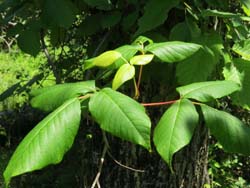Toxicodendron radicans
Poison Ivy
[ click on any image below to see larger version ]
Family:
Anacardiaceae
Mid-Atlantic bloom time:
late April - early June
Mid-Atlantic fruit ripe:
August - October
Caution:
Poison Ivy and its kin contain urishiol, an oil that causes contact dermatitus (blisters and rash) in most people.
Do not touch, cut or crush at any time of year, and especially do not burn it because the smoke can inflame lung tissues.
The oil can persist on skin, fur, clothing and shoes until washed off,
but once washed completely, affected areas of the skin will not spread to other areas or to other persons.
It is normally a vine, climbing by using adventitious roots along its stem,
by which it can reach the tops of tall trees (the species name radicans means "with stems that take root").
The stem on the tree trunk thickens to a dark, hairy-looking vine.
It can also form stands of free-standing plants up to a meter high.
Birds eat the seeds and readily propogate the plant.
Poison Ivy is usually found in wet areas, but can also grow in dry areas.
To the uninitiated, the climbing vine looks similar to
Virginia Creeper (Parthenocissus quinquefolia),
but Poison Ivy's compound leaves have 3 leaflets, not five.
20 June 2014
Manassas National Battlefield Park, Manassas, VA

|
20 June 2014
Manassas National Battlefield Park, Manassas, VA

|
20 June 2014
Manassas National Battlefield Park, Manassas, VA
(in flower)

|
20 June 2014
Manassas National Battlefield Park, Manassas, VA

|
20 June 2014
Manassas National Battlefield Park, Manassas, VA
(developing seeds)

|
20 June 2014
Manassas National Battlefield Park, Manassas, VA
(showing hairy Poison Ivy vine on tree trunk)

|
28 April 2015
Manassas National Battlefield Park, Manassas, VA
(new leaves on vine on tree trunk)

|
28 April 2015
Manassas National Battlefield Park, Manassas, VA
(new leaves on a free-standing specimen)

|
Return to list of flora







